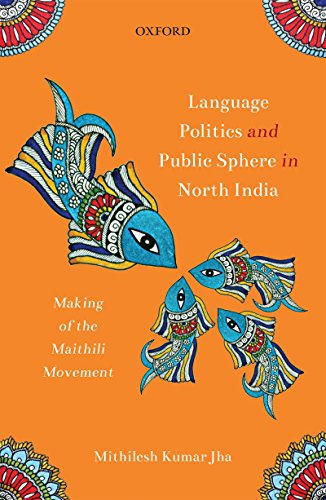The rich literary and historical trajectory of Maithili language and its recognition as a distinct identity, both linguistic and cultural-political have been well documented and examined in Mithilesh Kumar Jha’s Language Politics and Public Sphere in North India: Making of the Maithili Movement. It is a sophisticated and well-argued work cutting across the disciplinary boundaries of History, Sociology, Political Science, Cultural Studies and Linguistics. It is a valuable addition to the existing robust set of earlier writings by Jyotirindra Dasgupta, Baldev Raj Nayyar, Paul Brass, Uday Narain Singh, Christopher King, Vasudha Dalmia, Francesca Orsini, Lisa Mitchell and Farina Mir among others. Taking the debate on language politics further through the case study of Maithili language, the author intends to move beyond the given and established hegemonic discourse of Hindi-Urdu language debate that has dominated much of the language question since the late nineteenth century in modern India. The discourse pertaining to the nationalization of Hindi and making it a dominant hegemon particularly in the first half of the twentieth century India rested upon the politics of classification and categorization of languages and dialects whereby the latter were subsumed and listed under the major languages. The numerical dominance of Hindi over and against other languages was made possible by listing Khari Boli, Bagheli, Bundelkhandi, Rajasthani, Braj, Awadhi, Bhojpuri, Magadhi, and Maithili among others as dialects of Hindi. This sort of enumerative logic had obvious political goals to achieve particularly during the years of 1920-50s when the communalization of the language question with respect to Hindi-Urdu had already been on violent rise associating and collating it with dominant identities of religion, caste, region and nation. The ‘Hindi heartland’ saw the communal polarization evoked through slogans like Hindi/Hindu/Hindustan and Urdu/Muslim/Pakistan during this period. Jha’s book shows why the rise and dominance of Hindi language were being interrogated and challenged by several other languages or dialects within the Hindi heartland itself.
The introduction analyses the contours of nationalism discourse in both western and non-western traditions which have addressed the category of language as a form of collective cultural identity. The Andersonian thesis of desacralization of Latin and rise of vernaculars along with the emergence of print capitalism explained the particular forms of linguistic nationalism in Western Europe. The author argues with much persuasion that the distinction between language and dialects or regional variants is not linguistically given or naturalized. Rather it rests upon a number of historical and political conditions, language and cultural elites’ perception and articulation of the demands of particular dialects or lesser known languages, their literary and leadership skills, organizational strength of particular language communities and their deep sense of political and cultural engagement and consciousness with dominant language communities and groups at a particular historical conjuncture.

